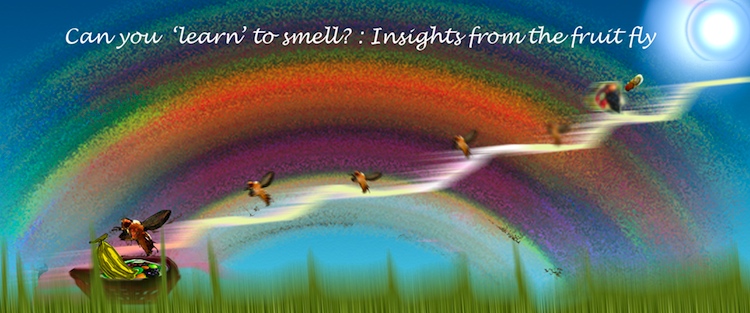Can you ‘learn’ to smell? Insights from the fruit fly
A team of neuroscientists at NCBS Bangalore (Tuhin Subhra Chakraborty, Sarit Pati Goswami and Obaid Siddiqi) in collaboration with Atulya Iyengar and Prof. Chun-Fang Wu at University of Iowa, USA, have been exploring the neurological and behavioral aspects of olfaction, with the fruit fly Drosophila. In their most recent study, published in the Proceedings of the National Academy of Sciences, they were able to confirm their previous finding on sensitization of the ORNs: that flies develop preferences to the odors they encounter during the first few days of adult life.
Using a statistical technique based on Jensen-Shannon divergence of neuron firing patterns, their study suggests that sensory neuron-based learning goes much farther. If young adult flies are to learn how to discriminate between similar odors, and between odors of different intensities, they must be raised in an environment that provides a rich olfactory experience. Befitting the mysterious nature of the world of smell, this process of learning is referred to as “imaginal conditioning”, but the origin of the term is somewhat more mundane: imago is the technical word for the adult stage of an insect’s life-cycle.
It has long been known that Drosophila has a sophisticated olfactory system that allows it to differentiate between various odorants. The perception of these odorants is essential for the fly to identify relevant food sources and suitable sites for laying eggs. Also, olfaction in Drosophila is linked with a variety of behaviors- associative learning, courtship, foraging etc. It has also been known for many years that a fly’s individual olfactory experience of the world shapes its nervous system in some way so that the fly can make appropriate second-to-second decisions based on the odors it encounters. The work of the NCBS-University of Iowa team over recent years is exciting because it has shown that much of that shaping occurs in the very nerves that detect odors in the first place.
The most recent study exposed adult flies that were freshly hatched from their pupa - an event called eclosion - to odors of different esters (chemical compounds that smell fruity) for a duration of 3 days. This differential exposure was achieved by raising flies on one of 3 different media - an odorless synthetic medium, a number of media containing a single ester, or cornmeal medium - a complex medium rich in odors. The authors found, as in their previous work, that exposure to a single odor leads to the the strongest priming of the ORNs that have the receptors appropriate to detect that odor. This sensitization is broad - the nerves also develop a responsiveness to chemicals related to the one the flies were originally exposed to.
But the most interesting responses were from the flies exposed to the cornmeal medium, which had originally been been envisaged, as in previous studies, as an experimental control. These flies showed the greatest capacity to differentiate between various odors and to discern small differences in the concentrations of an odor. This makes a lot of sense given that the cornmeal medium mimics more closely, at least with respect to odor complexity, the type of environment a fly would normally inhabit, and within which a fly would benefit if it could discriminate odors in as many ways as possible. There’s obviously something to be said for growing up in an average place!
The secret powers of the cornmeal flies were only unmasked by the authors’ applying some advanced mathematical techniques, that served as analytical “x-ray specs”. Using a statistical measure first developed by information theoreticians, the Jensen-Shannon divergence, and finding ingenious ways to use it that had not been attempted before, the authors were able to tease apart the firing patterns of the ORNs. Previous analyses had been relatively crude, and restricted to counting how many times a nerve had fired, but the new approach could also reveal clustering patterns of nerve firing.
The study emphasizes the important role that sensory neurons can play in tuning the sensitivity and specificity of various neurons to external stimuli. Although the underlying mechanisms of why and how odor experiences affect the coding of ORNs have not yet been fully deciphered, the study highlights the possible impact of sensory neurons on the processing of information in the central nervous system, thereby regulating behavior. “We will continue to work on mapping various ORNs to different odors of varying intensities under different conditioning schemes”, says Tuhin.


Comments
Love the pic :) Andrew Do
Congrats AI and TSC! Hats off
Post new comment